
F.W. BELL Model 7030 Gauss/Tesla Meter Instruction Manual
iv
List of Illustrations
Figure 1-1 Front Panel……………………………………………………………………….. 1-6
Figure 1-2 Rear Panel…………………………………………………………………….….. 1-7
Figure 1-3 Various Positions of Instrument………………………………………………… 1-8
Figure 2-1 Frequency Response of Uncorrected Analog Outputs (%Deviation)………. 2-3
Figure 2-2 Digital I/O Connector……….……………………………………………………. 2-4
Figure 2-3 Zero Flux Chamber………………………………………………………………. 2-6
Figure 3-1 7000 Series Probe Ordering Guide…………………………………………….. 3-2
Figure 3-2 Hall Probe Configurations………………………………………………….……. 3-4
Figure 4-1 Probe Electrical Warning………………………………………………….…….. 4-2
Figure 4-2 Fuse Panel……………………………………………………………………..…. 4-3
Figure 4-3 Adjusting the Handle………………………………………………………….…. 4-4
Figure 4-4 Installing and Removing Probes…………………………………………….….. 4-5
Figure 4-5 Power Switch Positions………………………………………………………….. 4-6
Figure 4-6 Boot Up Screen…………………………………………………………………... 4-7
Figure 5-1 Front Panel Keys…………………………………………………………………. 5-2
Figure 5-2 Menu Items……………………………………………………………………….. 5-3
Figure 5-3 Using Selections…………………………………………………………………. 5-4
Figure 5-4 Main Menu……………………………………………………………………….. 5-4
Figure 6-1 Present Flux Density Reading………………………………………………….. 6-3
Figure 6-2 Measurement Mode Indicator…………………………………………………... 6-3
Figure 6-3 Frequency / Filter Indicator……………………………………………………… 6-5
Figure 6-4 Indeterminate Frequency Indicator……………………………………………. 6-6
Figure 6-5 Relative Value Indicator………………………………………………………… 6-14
Figure 6-6 7000 Series 3-Axis Probe Orientation………………………………………… 6-16
Figure 6-7 Example Circuit for Classifier Outputs………………………………………… 6-22
Figure 6-8 Probe Output Versus Flux Angle………………………………………………. 6-23
Figure 6-9 Probe Output Versus Distance…………………………………………………. 6-24
Figure 6-10 Flux Density Variations in a Magnet…………………………………………… 6-24
Figure 7-1 IEEE-488 Connector……………………………………………………………. 7-2
Figure 7-2 RS-232 Connector………………………………………………………………. 7-4
Figure 7-3 Condition, Event, and Enable Registers………………………………………. 7-8
Figure 7-4 Status Byte and SRQ Enable Registers……………………………………… 7-9
Figure 7-5 Standard Event Register……………………………………………………….. 7-11
Figure 7-6 Measurement Event Register………………………………………………….. 7-12
Figure 7-7 Operation Event Register……………………………………………………….. 7-13
Figure 7-8 Questionable Event Register…………………………………………………… 7-13
Figure A-1 Flux Lines of a Permanent Magnet…………………………………………….. A-1
Figure A-2 Hall Effect Sensor……………………………………………………………...… A-2
Figure B-1 Two Dimensional Co-ordinate System………………………………………… B-1
Figure B-2 Vector Angle in a Two Dimensional System………………………………….. B-2
Figure B-3 Three-dimensional Co-ordinate System……………………………………….. B-3
Figure B-4 Vector Angles in a Three-dimensional System……………………………….. B-3


































